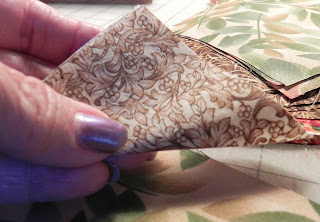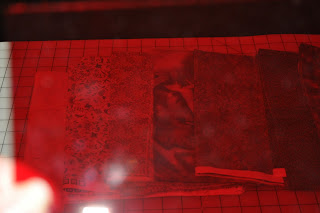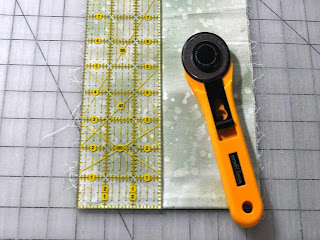My next step was to put them on my table in columns, because I had only 7 blocks of each color I made a slight change in size, and had 11 columns each 7 blocks long. If you have 90 blocks you will want to lay yours out in 10 columns 9 blocks long (10 x 9). I first tried a "scrambled" look with just putting them all out in any order. It didn't work so I decided to try a diagonal order, which worked much better. My diagonal went from upper left to lower right.
Once you have your lay-out decided, put a safety pin in the upper left hand corner of the top left hand block in each column across. This will help you orient the blocks after you have sewn them.
Now flip the top right hand block over the left hand block.
Take these to your machine and being sure to keep them in order sew down the right edge making a 1/4 in. seem allowance. Do not cut them apart, just keep right on sewing on the next two blocks. This is called chain piecing. It saves time, thread and helps keep the blocks in order.
Once you have finished your whole column of blocks, lay them back down on your table and flip them open to lay flat. Use your safety pin in the upper left block to orient each column correctly.
You will notice there is a small chain of thread holding each pair together in the column. Now take the first column to your sewing machine. Flip the top 2 blocks over the second 2 blocks and matching edges and center seem, sew them together.
Your chain of blocks will be out to the left of your sewing.
 |
In this picture the top 2 sets of blocks are sewn together. Keep flipping the sewn blocks over the unsewn ones and always matching the center seem, sew them together. Sew each column like this. You will have 5 double columns each 9 blocks long , if you are doing a 10 x 9 block quilt. I had 5 double columns and one single, each 7 blocks long for my 11 x 7 quilt.
Again I like to lay out my double columns out on a table (or floor, or bed or wherever you have space) and still using the safety pins to keep them in order, check to see that everything is lined up the way you want it. It is much easier to fix things now because our next step is to sew them all together.
And here it is, the finished lap quilt. I chose to put a border on mine of the same fabric as I used for the corners. I feel this works well and helps to hold the whole quilt together. After I layered the top, batting and backing together I machine quilted this one on the diagonal down the center of each large block.
I can see this quilt in many different colors and sizes and I'm sure I'll make it again. Wouldn't a shorter one done in the flat block be a great baby quilt?
Any questions or comments, please leave them and I will be glad to answer them.
Chris

























.JPG)
.JPG)
.JPG)
.JPG)

.JPG)
.JPG)























